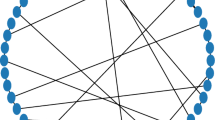Abstract
This study delves into the self-oscillation properties of complex neural networks to elucidate the intrinsic mechanisms driving biological rhythm generation and adaptation to external periodic signals. We scrutinize the influence of electrical coupling and Spike-Timing-Dependent Plasticity (STDP) on network synchronization. Employing a neural network characterized by scale-free topology, we observe that neurons with higher node degrees necessitate activation by an increased number of fellow neurons. Central neurons emerge as pivotal in facilitating swift excitation propagation. In contrast, low-degree circuits sustain activity during burst intervals, with circuit length inherently dictating the rhythmic period. Notably, despite their inherent complexity and diverse rhythm generation, neural networks can adaptively select a low-degree loop congruent with external input rhythms via Hebbian learning principles. These insights offer profound implications for comprehending the variances in human biological rhythms across different environments and hold significant value for planning extended space expeditions.
Access this chapter
Tax calculation will be finalised at checkout
Purchases are for personal use only
Similar content being viewed by others
References
Mistlberger, R.E., Skene, D.J.: Social influences on mammalian circadian rhythms: animal and human studies. Biol. Rev. 79(3), 533–556 (2004)
Buzsaki, G., Draguhn, A.: Neuronal oscillations in cortical networks. Science 304(5679), 1926–1929 (2004)
Watts, D.J., Strogatz, S.H.: Collective dynamics of ‘small-world’ networks. Nature 393(6684), 440–442 (1998)
Bullmore, E., Sporns, O.: Complex brain networks: graph theoretical analysis of structural and functional systems. Nat. Rev. Neurosci. 10(3), 186–198 (2009)
Barabási, A.L., Albert, R.: Emergence of scaling in random networks. Science 286(5439), 509–512 (1999)
Buzsáki, G.: Rhythms of the Brain. Oxford University Press (2006)
Sporns, O.: Networks of the Brain. MIT Press (2016)
Bassett, D.S., Bullmore, E.D.: Small-world brain networks. Neuroscientist 12(6), 512–523 (2006)
Breakspear, M.: Dynamic models of large-scale brain activity. Nat. Neurosci. 20(3), 340–352 (2017)
Bliss, T.V.P., Collingridge, G.L.: A synaptic model of memory: long-term potentiation in the hippocampus. Nature 361(6407), 31–39 (1993)
Buzsáki, G., Wang, X.J.: Mechanisms of gamma oscillations. Annu. Rev. Neurosci. 35, 203–225 (2012)
Turrigiano, G.G., Nelson, S.B.: Homeostatic plasticity in the developing nervous system. Nat. Rev. Neurosci. 5(2), 97–107 (2004)
Huo, S., Tian, C., Kang, L., et al.: Chimera states of neuron networks with adaptive coupling. Nonlinear Dyn. 96, 75–86 (2019)
Feng, P., Wu, Y.: Pattern selection in multilayer network with adaptive coupling. Int. J. Bifurcation Chaos 33(05), 2330012 (2023)
Bi, Z., Zhou, C.: Understanding the computation of time using neural network models. Proc. Natl. Acad. Sci. 117(19), 10530–10540 (2020)
Mi, Y., Liao, X., Huang, X., et al.: Long-period rhythmic synchronous firing in a scale-free network. Proc. Natl. Acad. Sci. 110(50), E4931–E4936 (2013)
Liao, X., Xia, Q., Qian, Y., et al.: Pattern formation in oscillatory complex networks consisting of excitable nodes. Phys. Rev. E 83(5), 056204 (2011)
FitzHugh, R.: Impulses and physiological states in theoretical models of nerve membrane. Biophys. J . 1(6), 445–466 (1961)
Acknowledgements
We would like to thank Prof. Yuanyuan Mi for the very useful discussion. This work was supported by the key National Natural Science Foundation of China (Grant Nos.12132012), and Youth program of National Natural Science Foundation of China under Grant Nos. 12002252, and Opening project of State Key Laboratory (Grant No. SKL-YSJ201913).
Author information
Authors and Affiliations
Corresponding author
Editor information
Editors and Affiliations
Rights and permissions
Copyright information
© 2024 The Author(s), under exclusive license to Springer Nature Singapore Pte Ltd.
About this paper
Cite this paper
Feng, P., Ye, L., Adilihazi, X., Liu, Z., Wu, Y. (2024). Understanding Neural Rhythmic Mechanisms Through Self-oscillations of Complex Neural Networks and Their Adaptation. In: Jing, X., Ding, H., Ji, J., Yurchenko, D. (eds) Advances in Applied Nonlinear Dynamics, Vibration, and Control – 2023. ICANDVC 2023. Lecture Notes in Electrical Engineering, vol 1152. Springer, Singapore. https://doi.org/10.1007/978-981-97-0554-2_25
Download citation
DOI: https://doi.org/10.1007/978-981-97-0554-2_25
Published:
Publisher Name: Springer, Singapore
Print ISBN: 978-981-97-0553-5
Online ISBN: 978-981-97-0554-2
eBook Packages: EngineeringEngineering (R0)




